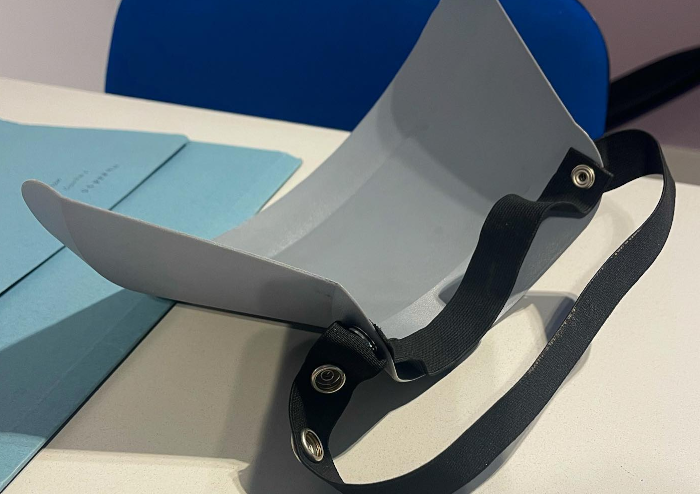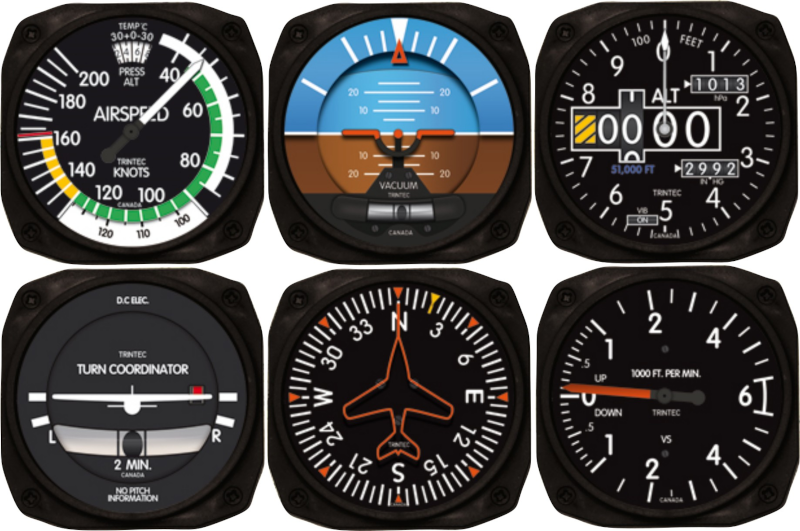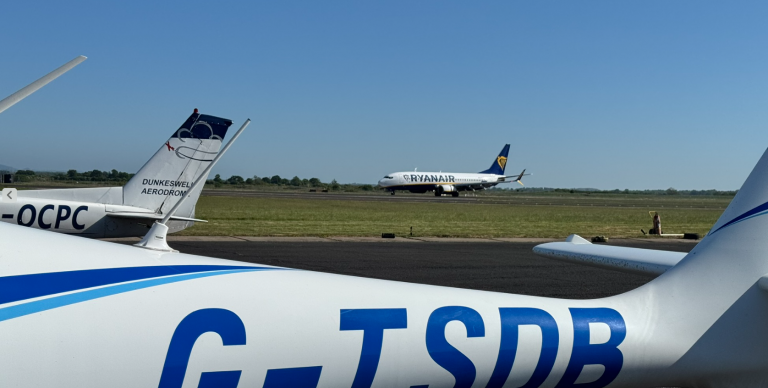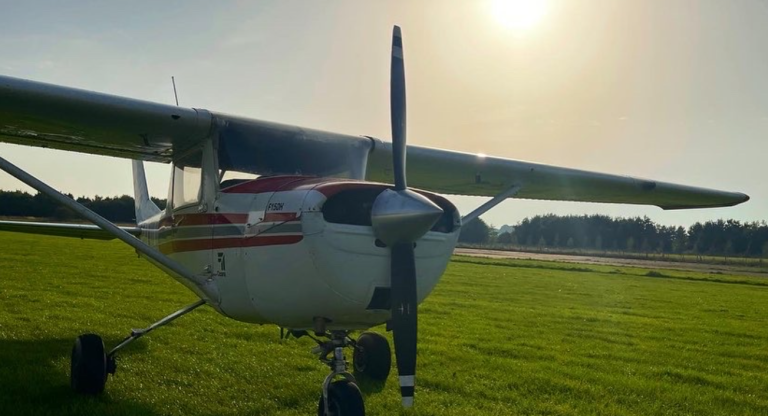
I did not expect to fly today. When I woke up it was raining and the sky was a dark grey in all directions, all the way to the horizon, but I drove the 45 miles to the airfield anyway, knowing I could do some ground-school with my instructor if we were grounded.
My instructor welcomed me in and said that it was the perfect weather for instrument flying, and did I know what to do if I inadvertently flew into a cloud?
I paused for a moment and thought about it logically. What did I know and not know? I didn’t know how big the cloud was, but I knew I’d recently been outside of the cloud. “I’d turn around 180 degrees and try to fly out of it.”
“Correct!” A good start! My instructor said that many people said they would try to fly through it, or climb, or descend. None of which are sensible when you don’t know the dimensions of the cloud – or if there are other aircraft inside it flying on instrument flight rules (IFR), which permits flight through clouds.
The Hood

Before we headed out to the aircraft my instructor passed me ‘the hood’, a device used to block a pilot’s view of the outside so they have to rely on instruments alone.
Once in the aircraft, with the engine started, checklists run, and run-up checks performed, we taxiied to the end of the runway, the previous disastrous take off hanging over me. Now with the presence of mind to know that the propeller running at full power would give rudder authority I pushed the throttle forward to full power, felt the resultant yaw and the yaw from the slight crosswind and corrected it with the rudder pedals before locking my knee in place so the rudder pedals didn’t move again.
This time, I tracked straight down the centre line, at 60 knots I smoothly but positively pulled back on the controls and the aircraft lifted off the ground. The nose lifted and I caught it just at the right moment, pitched for a 70 knot climb (speed is controlled by nose angle, “pitch”) and carried out my post-takeoff checks (TCF):
- T – Temperatures and pressures (T&Ps) in the green
- C – Carburetter heat – off
- F – ONLY when above 65 knots, above 300ft aal, and NOT descending: flaps up
Emergency!
Despite the big black soggy clouds that hung over us the air was silky smooth and the flying was pleasant. We headed east towards the coast, ducking under a descending cumulus cloud at the extremities of the large stormy overcast, before bursting through into glorious sunshine.
Before I got a chance to enjoy it though, we were going to practice an emergency. Across the UK the 121.500 frequency is operated by London Centre and is used for reporting emergencies. In this day and age, emergencies are few and far between so they actually allow you to practice emergencies on the real channel (with their permission).
We switched to their frequency and waited for a while to ensure we weren’t going to impede an ongoing real emergency.
“London centre, Golf-Alpha-Whisky-Oscar-Tango, request practice pan,” I said.
There are two types of emergency in aviation:
- Pan-pan-pan – which is where a pilot feels unsafe but life is not imminently in danger, such as a pilot getting lost, and;
- Mayday – life is immediately at risk, such as a single engined aicraft losing its engine and catching fire in the air.
It is not possible to practice maydays on the 12.1500, but you can practice pan-pan-pans, if you use the correct phraseology.
“Golf-Oscar-Tango, practice pan approved, squawk 7431 pass your message,” said London Centre.
I worked through the list my instructor had given me earlier, fitting in real details in the gaps. “Practice-pan, practice-pan, practice-pan, Golf-oscar-tango, simulating uncertain of position, type Cessna 150, last known position Eshott Airfield, altitude 2,500ft, heading 050 degrees, Student PPL, 2 POB [persons on board], 4 hours of fuel remaining.”
And then we waited.
My instructor informed me that he was using direction finders (DFs) to locate us. If three DFs could find us they could triangulate our position with high accuracy – useful for search and rescue situations.
As an aside, many aircraft with two radios (such as jet airliners) keep their second radio tuned to 121.500 so they can assist in relaying emergency details from aircraft lower down with less line-of-sight radio range, and with less powerful radio equipment. It’s amusing in retrospect to think there could have been commercial airline pilots listening to me pretend to be lost somewhere on the coast of Northumberland!
“Golf-Oscar-Tango, zero DF coverage in your area, radar contact 1 nautical mile west of Newton, do you need further assistance?” came the reply from London.
As rehearsed in the briefing room earlier, I replied, “negative, changing frequencies to Eshott Radio, 122.855, squawking conspicuity, thanks for the help.”
The conspicuity squawk code we mentioned is transponder code 7000 which lets radar-capable air traffic controllers know that you’re flying under visual flight rules (VFR) outside of controlled airspace. There are other standard codes worth knowing about: conspicuity code for IFR traffic is 2000, hijacking code is 7500, comms failure is 7600, (real) emergency is 7700. A 7700 squawk will light up on any nearby radar operator’s screens. 7002 is used by the Red Arrows, the Royal Air Force’s display team, and there are others too, listed on the Aeronautical information publication.
Instrument Flying
My instructor handed me the hood and said, “I have control.” Ignoring the BDSM euphemisms (thanks, Eurotrash when I was 13), I popped it over my head and could only see my six-pack. Not, unfortunately, my exquisitely crafted and toned stomach, but the six standard instruments that make up a typical training aircraft instrument set:
- Airspeed indicator
- Attitude indicator (aka ‘artificial horizon’)
- Altimeter (altitude indicator)
- Turn coordinator
- Direction indicator (DI)
- Vertical speed indicator (VSI)

And for the next hour using only these instruments I made turns, climbed and descended around Northumberland without seeing anything outside the window.
I also performed regular FREDAC checks – notably aligning the DI to the magnetic compass, which requires straight and level flight using instruments that have a natural delay on them is tricky!
“Good news,” said my instructor, “they’ve installed an ILS at the airfield so I’ll provide you with vectors.”
ILS is Instrument Landing System and is used by pilots to land at airports in low visibility. There absolutely wasn’t an ILS at the airfield (there’s not even a permanently-staffed radio) but I knew this fake ILS vectoring would be a good test of my instrument flying skills.
At a point in space which I couldn’t see I began descending at 70 knots with flaps down and the attitude indicator showing my nose just below the horizon. The altimeter said 500ft QNH. “Now lift the hood,” said the instructor.
Runway 01 at the airfield, the one I’d taken off from 65 minutes earlier, was right in front of me. I transitioned to visual flight, lining up the runway numbers as my datum.
The landing gear touched down.
“Full power,” said my instructor. I hesitated a moment, then pushed the throttles to the firewall. “I have control, we’ve not briefed go arounds yet,” he said, taking us back into the air.
Once airborne he handed the controls back to me, I flew the circuit at 1,000ft aal and then approached again, this time everything was lined up perfectly, the runway numbers sat stubbornly in the middle of the windscreen, the airspeed wouldn’t budge from 70 knots, the trim almost magnetically clicked to just the right place, wind was calm, I felt like I could take my hands off the controls and she would land herself.
As the runway started to get large in the windscreen I throttled back to idle power, smoothly pulled back on the controls and the wheels almost imperceptibly rolled onto surface. Like butter on toast. By any measure, this was ‘a good landing’. Knowing even professional pilots have good and bad days, I enjoyed it while I could.
An apology
Sorry for the lack of photos in this one, I was stuck under a flipping hood for most of it!



